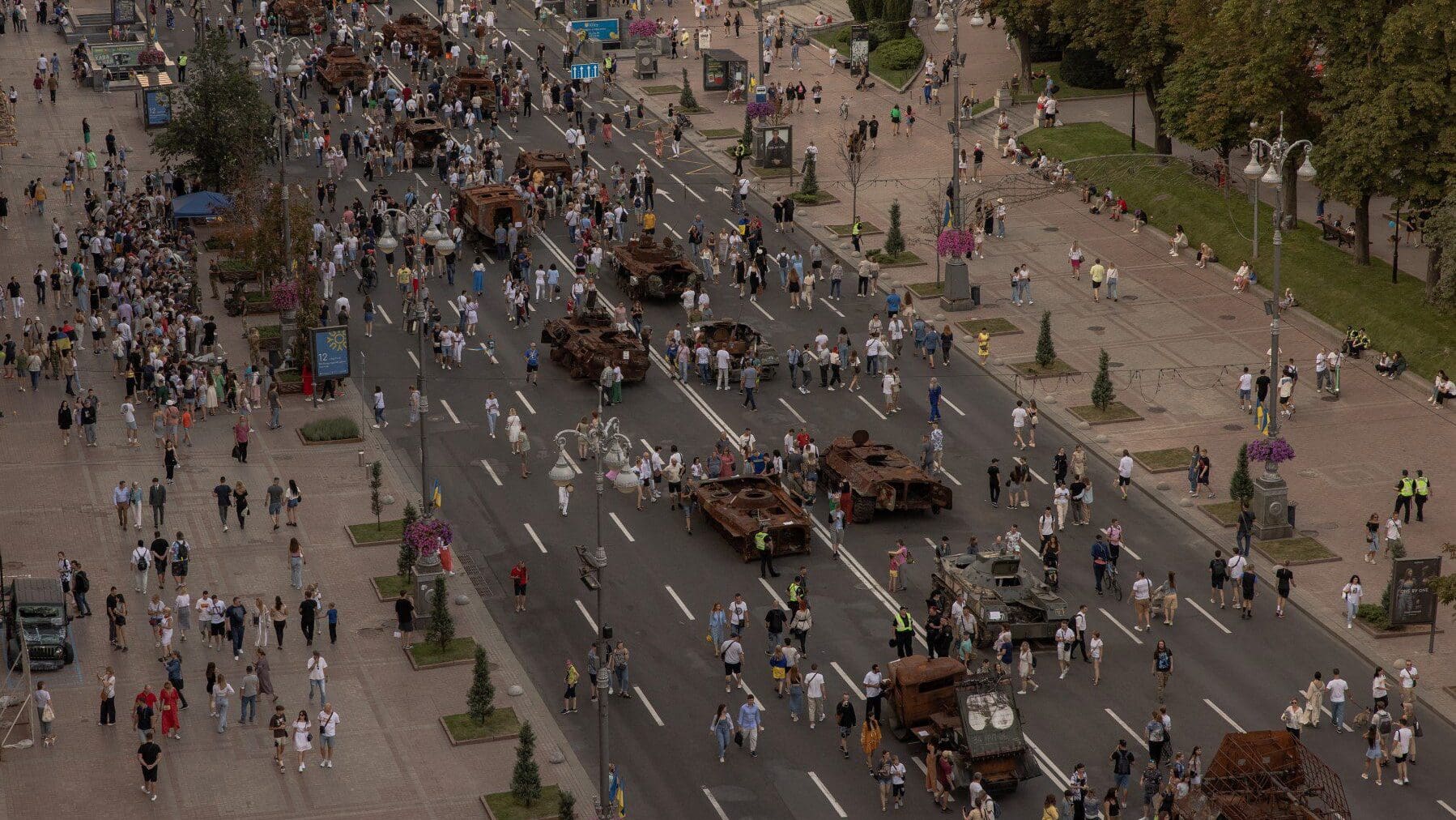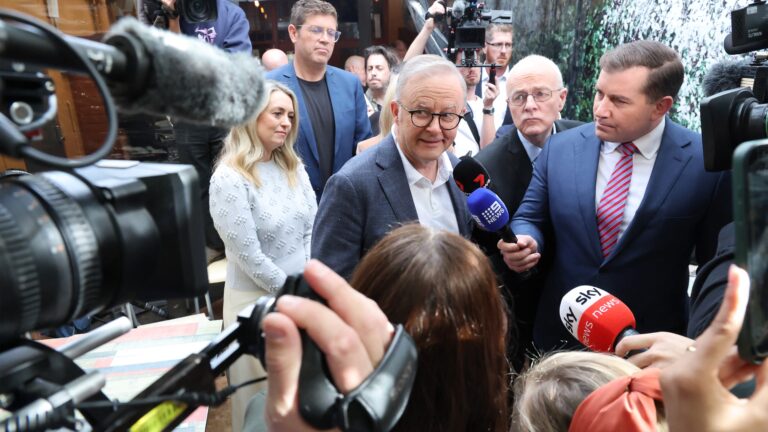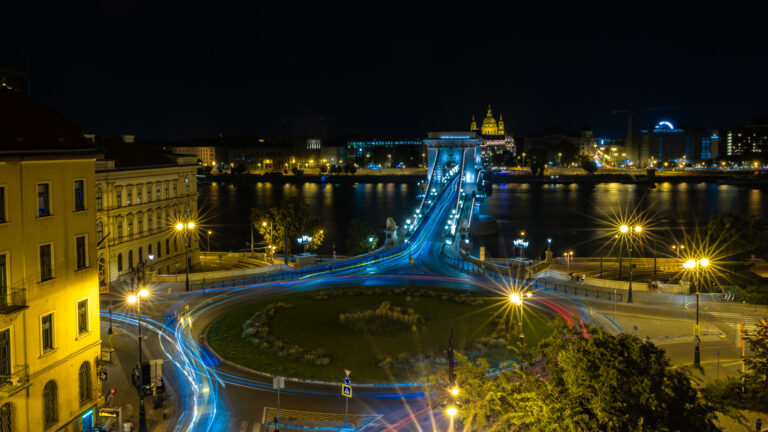‘You want to go and see the Russian tanks now?’ I was anything but impressed by my Ukrainian friend, Andy’s proposition. He promised that we would do something really special in Kyiv for Independence Day, that is 24 August. We’d just finished taking pictures with the Motherland monument, the 335-feet-tall titanium statue towering over Kyiv holding up a sword and a shield. Originally dedicated to Soviet victory in World War Two, the monument had just been ‘decommunized’: the sickle and the hammer on the shield having been replaced by the Ukrainian trident. Checking out the new design seemed like a fitting programme for the Independence Day of Ukraine, however, the hill atop which the monument stands has been off limits since the start of the invasion. We could only take photos from far away strolling on the bank of the Dnipro.
Not being able to see the picturesque panorama of Kyiv in the sunset from the feet of the Motherland monument was already a disappointment. And now we were supposed to visit the dozen or so burnt-out Russian vehicles—not even all of them were tanks—next to Saint Michael’s Golden-Domed Monastery? The charred mementos of Putin’s aborted march on Kyiv placed around the Princess Olga monument has been on top of the ‘must see’ list for foreigners arriving in the Ukrainian capital for more than a year now. During Joe Biden’s surprise visit in February to the embattled country, the US President could also be seen only a hundred feet away from the burned-out vehicles.
I told Andy that I’d already seen the tanks a year ago. ‘I mean the tanks on Maidan and Khreshchatyk.’ Maidan Nezalezhnosti—Independence Square in Ukrainian—is arguably the most important representative public space in Kyiv; its political symbolism being similar to that of Kossuth Square in Budapest. The colossal triumphal column standing in front of a semi-circular backdrop is reminiscent of the Hungarian capital’s Heroes’ Square. The Maidan—‘the square’ as people refer to it—became a plaza of fallen heroes in 2014: pictures commemorating the 108 protestors killed by law enforcement during the Revolution of Dignity
remind everyone that for Ukrainians the struggle for self-determination didn’t start in February 2022.
My usual before-the-midnight-curfew jogging would take me to Maidan through the wide sidewalk of the gently bending Khreshchatyk Street. Last time I checked—which was the day before—, the only vehicles there were cars stuck in the insane morning traffic.
Obviously, that had changed the previous evening. When we finally emerged from the labyrinth-like underpass, tens of thousands of people were crowding the eight-lane-wide asphalt of Khreshchatyk Street in front of Maidan. I immediately felt exposed, even naked. I looked up at the sky with growing apprehension. I am in a huge crowd during Ukrainian Independence Day gathered on the most symbolic square in the country. A perfect target for those hypersonic ballistic missiles. I learned a few days before what ‘nigh’ really meant when people were talking about the nigh impregnable air defences of Kyiv. After hearing two loud explosions—and receiving a ‘GO TO SHELTER NOW!!!’ text from Andy—I was rushing from my apartment off Khreshchatyk Street to the safety of the Kyiv metro. It took some time to shrug off my apprehension; although there was no air alarm, two metro stations would most definitely not be able to fit tens of thousands of people if the explosions started.
I turned and immediately realized that the barrel of a Russian tank was pointing right at me. It was not burnt out like the ones next to St. Michael’s Golden-Domed Monastery. Seemingly intact, it was heading a frozen parade of Russian armoured combat vehicles: T-72 main battle tanks, towering 2S19 Msta-S self-propelled howitzers, smaller infantry fighting vehicles, and various other metal objects tracked or on wheels that were beyond my rudimentary knowledge of Russian military hardware. Neatly arranged into two columns, the march stretched roughly 2200 feet on Khreschatyk Street from Maidan all the way to TSUM department store.
The very first emotion that I got from the crowd was innocent curiosity. Taking halting steps in silence, turning their heads, people at first seemed like islands gently touching, examining, walking around the vehichles, self-consumed by the need to take in and process this extraordinary display. I saw a five-year-old kid raising the downward-pointing gun of a tank above his head then letting it slowly drop back into its original position, then starting the process all over again. Reminded me of some larger-than-life seesaw.
An eerie funerary melody was approaching. A man on stilts, dressed in brown furs wearing a Mardi Gras-esque hat was pulling a metal cage on wheels, with an effigy of Putin on its knees inside it. The prisoner in striped uniform was clinging to the metal bars entrapping him, his face bearing an expression of pure despair.
The self-consumed people-islands around me swiftly transformed into something else.
The crowd ebbed, flowed, and parted around the casually walking performer phones in hand—including me—recording. The Putin-as-mannequin resembled a trapped Quasimodo from Victor Hugo’s Feast of Fools. Except there was no jeering—it would have ruined the perfect Instagram matériel of course.
We started walking down Khreschatyk Street. Armed with chalks—we had no idea where they had come from—people were angrily scribing messages onto the defunct Russian hardware. ‘Crimea is Ukraine’ was arguably the most popular one. I kept asking Andy to translate them but half of the time I got the same response: ‘It’s a very complicated insult, I don’t know how to say it in English.’ As I looked longer and longer, I realized: people were not writing, they were piercing, slicing, carving up the tanks, butchering them with their blunt instruments, pushing the chalk on the metal so hard that it kept shattering again and again. The fallen pieces were promptly picked up by onlookers who immediately joined the slaughter. The stark, silent determination of the scribblers, all the anger rushing to their faces was something I had only seen once before: on historical footage recorded during the twilight days of the GDR when people started demolishing the infamous Berlin wall using small household hammers.
The ubiquitous street singers and musicians of Khreschatyk Street were having a blast that day. Whenever one of them started performing a patriotic Ukrainian song it sent waves travelling at the speed of sound through the crowd. From one second to the next everyone around me was solemnly singing in unison in Ukrainian with their heads held high. We didn’t even hear the street performer who originally started the song. As I watched Andy dissolve into the singing, suddenly I felt like an outsider, a foreign object cast into a furious sea of defiant, unbreakable patriotic unity. If singing was a weapon, the war would have ended on Independence Day.








